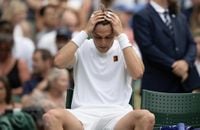Jack Draper is back in the spotlight, and the tennis world is buzzing with anticipation. The 23-year-old British star, once sidelined by a persistent arm injury, is now gearing up for a major comeback at the US Open, which kicks off in late August 2025. For Draper, this isn’t just another tournament—it’s a chance to reclaim his place among the sport’s elite and prove that adversity can be the catalyst for greatness.
Draper’s rapid ascent through the ATP rankings was nothing short of sensational. After clinching his first Masters title at Indian Wells, he surged into the ATP top-5, igniting a wave of excitement and high expectations. Fans and analysts alike pegged him as one of the brightest young talents on the tour, especially as Wimbledon 2025 approached. But tennis, as always, had its own script in store.
Wimbledon delivered a jarring twist. Draper, tipped by many to make a deep run, suffered a shock second-round exit at the hands of veteran Marin Cilic. The loss was a gut punch—not just for Draper, but for the legion of supporters who had rallied behind his breakout season. At first, Draper shouldered the blame, expressing disappointment in his performance. But as the dust settled, a deeper truth emerged: he had been battling a nagging arm injury that had quietly undermined his game.
In a revealing interview with the Lawn Tennis Association (LTA), Draper opened up about the hidden struggle. “The doctors and my team advised me that I’d need to take some time out. I had a few days off, so I chilled and took my mind off tennis,” Draper explained. The injury, he admitted, had been an issue “for a little while,” subtly eroding his confidence and effectiveness on court. The decision to pause wasn’t easy, but it was essential for both his physical and mental recovery.
The aftermath of Wimbledon was a period of reflection and recalibration. Draper’s medical team recommended a break, and he heeded their advice, missing the prestigious Toronto and Cincinnati tournaments. While some might see those absences as setbacks, Draper viewed them as opportunities. He dedicated himself to a rigorous fitness program, focusing on rebuilding his strength and resilience. The hiatus became a turning point—a chance to transform frustration into fuel.
“I’m in a great place now,” Draper declared in his LTA interview, his optimism unmistakable. “It was disappointing to miss Toronto and Cincinnati, but I think it’s been a good period for me to reflect on things and improve.” The time away from competition allowed him to reset, both physically and mentally. He emerged from the break feeling “refreshed, motivated, and I can’t wait to get back out there.” Those words, echoing through tennis circles, have reignited hope among fans eager to see Draper return to his dynamic best.
Draper’s resilience is rooted not just in his recent recovery, but in the experiences that have shaped his young career. The memory of last year’s US Open still lingers—a tournament where he captivated audiences by storming into the semifinals. That remarkable run ended at the hands of Jannik Sinner, who would go on to claim the title. For Draper, the defeat was bittersweet: a reminder of how close he’d come, and a motivator to push even harder.
Now, as the US Open draws near, Draper faces a new set of challenges. Without recent match play—owing to his injury and missed tournaments—questions swirl about his readiness. But if there’s one thing Draper has proven, it’s his ability to adapt and rise to the occasion. His approach to adversity has been nothing short of inspiring. “I feel refreshed, motivated, and I can’t wait to get back out there,” he reiterated, reinforcing his determination to make this comeback count.
The broader tennis community has taken notice. Draper’s story resonates not just because of his talent, but because of his candor and perseverance. Young athletes often struggle with the pressure to play through pain, yet Draper’s willingness to prioritize his health sets a powerful example. The decision to step back, regroup, and return stronger is a testament to his maturity—rare for a player of just 23 years old.
Of course, the road ahead won’t be easy. The US Open field is stacked with seasoned veterans and hungry newcomers, all vying for glory on the sport’s grandest stage. Draper’s lack of recent competitive matches could be a hurdle, but his renewed physical and mental strength might just tip the balance. There’s a sense of unfinished business—a hunger to prove that last year’s semifinal run was no fluke.
Fans are already speculating about potential matchups and storylines. Could Draper face off against Jannik Sinner again, seeking redemption for last year’s defeat? Will the time away from the tour translate to fresh legs and sharper focus, or will rust prove difficult to shake off? The answers will unfold in New York, under the bright lights and electric atmosphere of the US Open.
For now, Draper remains the center of attention—a symbol of resilience and hope in a sport that demands both. His journey from the heights of Indian Wells, through the heartbreak of Wimbledon, to the brink of a US Open return, is a testament to the unpredictable, thrilling nature of tennis. The setbacks, the comebacks, the relentless pursuit of excellence—it’s all part of the story.
As the countdown to the US Open continues, one thing is certain: Jack Draper’s comeback is more than just a personal triumph. It’s a reminder that even in the face of adversity, with the right mindset and support, the next chapter can be the most exciting yet. The world will be watching as Draper steps back onto the court, ready to chase his dreams once more.
